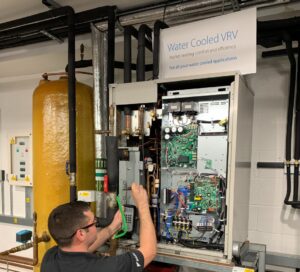With the hugely successful Feed-in-Tariff scheme for producers of renewable electricity set to close later this month, Will Vooght, Innovation and Strategy Lead at Tonik Energy, discusses what both suppliers and customers can do to best prepare.
Goodbye FIT
Since 2010, the Feed-in Tariff (FIT) scheme has guaranteed payments to around 900,000 generators for the total amount of electricity that’s produced, as well as for any energy exported to the grid – delivering a nice, attractive financial return on investment (ROI). And it’s this ROI that has been the major contributor for this astronomic growth in the sector. These generators are producing electricity that’s mostly used on-site; powering homes and businesses by renewable electricity generated ‘behind the meter’ – the side of the owners’ property where electricity is used, and before the point at which the normal electricity grid connects.
However, following the Government announcing its intention to remove these payments in 2015, the Department for Business, Energy and Industrial Strategy (BEIS) stated in summer 2018, that they were closing the doors on FIT from April 2019.
There’s still time!
If you’re in the camp of getting your on-roof solar in before deadline day – there’s still time, but don’t dawdle! The guidance here is black-and-white but varies somewhat on the technology being installed and the size of the installation.
If your solar solution is below 50kW, and you aren’t a school or community building – your generator needs to be installed, operational and all of your documentation issued by your installer before the 31st March 2019. You’ve then got a grace period of 12 months to register your site with your supplier. If you miss either of these dates – you’ll be ineligible for FIT.
As a rule, solar generators above 50kW will have 6 months to convert their pre-accreditation to a full accreditation following the 31st March deadline. Wind will have 12 months and hydro will have two years.
Community or School installations above 50kW will receive an addition 6 months on top of these timelines to apply. Smaller-scale community and school installations – below the 50kW capacity cut-off – have until 31st March 2020 to complete their application, but the site MUST have been commissioned and all supporting documentation produced (namely their Microgeneration Certification Scheme certificate) on or before the 31st March 2019.
It’s important to note that access to FIT rates isn’t guaranteed. The funding of the scheme – while paid for through everyone’s energy bills – has artificial caps placed on it via something called the Levy Control Framework. This caps the total spend on the FIT scheme, with specific spending and total capacity caps set at particular tariff levels.
My gut and a bit of analysis of the published statistics tells me that some of these tariffs will fill up very soon, if they’re not already. So, if you’re sat on an application that needs to be completed, I’d advise doing it soon!
Ofgem publish these caps on a regular basis, which can be seen here.
Hello SEG
During the summer 2018 consultation, BEIS received pressure from industry groups who said that the removal of this subsidy would leave would-be microgenerators in the lurch; they argued that without having a route to market, the electricity generated would effectively be entering the grid unclaimed and unpaid for. Not only is this unfair, but there is also a risk that BEIS is breaching some European energy laws about a requirement for member states to provide a market for renewable generators of all sizes.
So what’s the alternative to FIT?
It isn’t practical to make these small generators to set up Power Purchase Agreements (PPAs) like large generators such as offshore wind farms or commercial solar farms.
Enter the Smart Export Guarantee (or ‘SEG’ as the industry needs a few more acronyms!)
To align with the Government’s ambitions set out in the Industrial Strategy, SEG is designed to be a ‘market mechanism’; an obligation on energy suppliers to offer an export payment. This will create a route to market so that newly-installed microgenerators will get paid for the power they’re pumping into the grid; and mirrors the way large commercial generators currently receive payment.
BEIS have attempted to ensure that customers are protected, have a guaranteed route to market and the post-subsidy sector has a level playing field. However, the reality of it is, without subsidy and in seeking a ‘market mechanism’, we’re playing an entirely new game.
Is it going to work?
There’s a real risk that the SEG is so full of admin, friction and process – it will stifle innovation in the sector – which is the last thing we want to see. We believe the industry will suffer a difficult post-subsidy hangover period, so now is the time to ensure that any regulatory shackles are well and truly off, so suppliers can go to market with new, compelling and potentially never-seen-before propositions.
The real test for post-subsidy is going to be time, competition, trial and error. As an industry, we just hope the would-be generators of tomorrow can get over the ROI hump.
Customers installing new generators aren’t going to be left out in the cold by suppliers – it’s in our interest to win what are some of the most valuable and progressive customers in the market. These people hold the potential to change the entire relationship our members have with their energy.
















